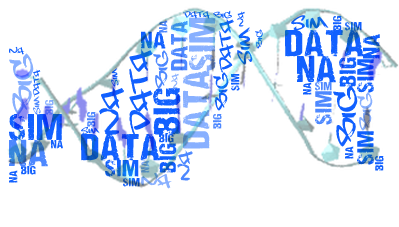BIGNASim database structure and analysis portal for nucleic acids simulation data
Example 4. Analysis using fragment hierarchy. Correlation between CpG twist and ζ torsions.
Analysis using fragments hierarchy. Correlation between CpG twist and ζ torsions.
The analysis of nucleic acids flexibility involves a large number of properties, from helical parameters, to hydrogen bonding or stacking energies, dihedral torsions, and distances, among others. Expert users usually combine such analyses in consistent ways, as they are highly correlated, and the combined study gives additional insight in the basis of conformational shifts. This practice requires to combine analyses done at different levels, the base-pair step (two contiguous base pairs), like twist or roll and analysis at the base pair level, like the hydrogen bonding pattern, or backbone torsions of the involved nucleotides. An expert DNA modeller has no problem on doing this manually, but it is a tedious and error-prone activity. BIGNASim includes the hierarchic relationships between sequence fragments (from individual bases to bp-steps), taken automatically (see Figure S2 and Table S5) from the simulation topology, and can be used to perform this kind of analysis in a straightforward way. We present here the necessary pipeline to analyse the correlation between CpG step twist and the ζ torsions of the neighbouring nucleotides. The high twist/low twist conformational change in the d(CpG) base pair step is one of the most surprising sources of polymorphism in B-DNA. A detailed study of the phenomena (11) is available. The study relates the twist polymorphism with the BI/BII transitions related to ζ/ε backbone torsions. The key correlation analysis (See Figure 3 on reference (11) implies to obtain the Twist helical parameter of the CpG bp-step and the ζ torsion of the two G bases at 3’ of the CpG step. This specific analysis could be done through the portal, obtaining the twist and ζ as described in the previous examples, and downloading the corresponding raw data. However to illustrate the power of the MongoDB database structure the following Javascript code shows the pipeline required to obtain such combined set of data from BIGNASim database.
Javascript code pipeline to generate a combined analysis of a CpG base pair step Twist and ζ torsions of 3’ G nucleotides in NAFlex_DDD_800ns simulation.
//
//Step 1. Locate available CpG bp-steps
// CpG bpsteps are indicated with a idGroup of CGCG. CpG is symmetrical, but in other
// cases both strands should be considered. The “Class” field combines both possible
// orientations.
var IDSIM = "NAFlex_DDD_800ns";
var BPStep = "CGCG";
var BP1 = "CG";
Bpstps = db.groupDef.find({'_id.idSim': IDSIM, 'class': BPStep}).sort({'_id.n': 1}).toArray();
//Alternatively search can be extended to “All simulations” with CG bpSteps available
//Bpstps = db.groupDef.find({'class': BPStep}).sort({'_id.n': 1}).toArray();
var TwCG = [];
var ZetaW = [];
var ZetaC = [];
printjson(Bpstps.length + ' ' + BPStep + ' found')
// Iterate over all CpG steps in the sequence.
for (i = 0; i < Bpstps.length; i++) {
IDSIM = Bpstps[i]._id.idSim;
//Step 2. Obtain relevant sequence positions.
// CGpos: Sequence position of first nucleotide in Watson strand. Used in the _id.
// G1pos: Sequence position of the Watson 3'G. n+1 nucleotide
// G2pos: Sequence position of the Crick 3'G. Corresponds to the complementary
// nucleotide on the first (n) base pair in the CpG step.
// “comps” field relates CG base pair with its component nucleotides, in
// this case comps[1] is the G nucleotide.
CGpos = Bpstps[i]._id.n;
G1pos = CGpos + 1;
G2pos = db.groupDef.findOne({'_id.n': CGpos, '_id.idSim': IDSIM, '_id.idGroup': BP1}).comps[1].n;
//Step 3. Collect twist values ordered by frame number.
TwCG[i] = db.analData.find(
{'_id.idSim': IDSIM,
'_id.nGroup': CGpos,
'_id.idGroup': Bpstps[i]._id.idGroup},
{'CURVES.helical_bpstep.twist': 1,
'CURVES.helical_bpstep.twist_avg': 1}).sort({'_id.frame': 1}).toArray();
// Step 4. Obtain ζ torsions values ordered by frame number
ZetaW[i] = db.analData.find(
{'_id.idSim': IDSIM,'_id.nGroup': G1pos,'_id.idGroup': 'G'},
{'CURVES.backbone_torsions.zeta': 1}).sort({'_id.frame': 1}).toArray();
ZetaC[i] = db.analData.find(
{'_id.idSim': IDSIM,'_id.nGroup': G2pos, '_id.idGroup': 'G'},
{'CURVES.backbone_torsions.zeta': 1}).sort({'_id.frame': 1}).toArray();
// Step 4.Output “Frame Twist G1Zeta G2Zeta”
for (i = 0; i < TwCG.length; i++) {
printjson(Bpstps[i]._id.idSim + ' ' + Bpstps[i]._id.idGroup + ' ' + Bpstps[i]._id.n)
for (k in TwCG[i]) {
if (TwCG[i][k]._id.frame > 0) {
printjson(TwCG[i][k]._id.frame + ' ' +
TwCG[i][k].CURVES.helical_bpstep.twist + ' ' +
ZetaW[i][k].CURVES.backbone_torsions.zeta + ' ' +
ZetaC[i][k].CURVES.backbone_torsions.zeta);
}
}
}
}



